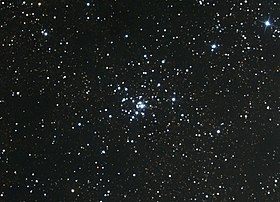| Messier 21 | |
|---|---|
 Open cluster Messier 21 in Sagittarius Credit: John Saunders | |
| Observation data (J2000.0 epoch) | |
| Right ascension | 18h 04m 13.0s[1] |
| Declination | −22° 29′ 24″[1] |
| Distance | 3,930 ly (1,205 pc)[2] |
| Apparent magnitude (V) | 6.5[3] |
| Apparent dimensions (V) | 14.0′[4] |
| Physical characteristics | |
| Mass | 783.4[5] M☉ |
| Radius | 12 ly (3.6 pc)[5] |
| Estimated age | 6.6×106 years[5] |
| Other designations | M21, NGC 6531, Cr 363, OCl 26.0[6] |
| Associations | |
Messier 21 or M21, also designated NGC 6531 or Webb's Cross, is an open cluster of stars located to the north-east of Sagittarius in the night sky, close to the Messier objects M20 to M25 (except M24). It was discovered and catalogued by Charles Messier on June 5, 1764.[7] This cluster is relatively young and tightly packed. A few blue giant stars have been identified in the cluster, but Messier 21 is composed mainly of small dim stars. With a magnitude of 6.5, M21 is not visible to the naked eye; however, with the smallest binoculars it can be easily spotted on a dark night. The cluster is positioned near the Trifid nebula (NGC 6514), but is not associated with that nebulosity.[8] It forms part of the Sagittarius OB1 association.[9]
This cluster is located 1,205 pc[2] away from Earth with an extinction of 0.87.[10] Messier 21 is around 6.6 million years old with a mass of 783.4 M☉.[5] It has a tidal radius of 11.7 pc,[5] with a nucleus radius of 1.6±0.1 pc and a coronal radius of 3.6±0.2 pc. There are at least 105±11 members within the coronal radius down to visual magnitude 15.5,[11] including many early B-type stars.[8] An estimated 40–60 of the observed low-mass members are expected to be pre-main-sequence stars,[8] with 26 candidates identified based upon hydrogen alpha emission and the presence of lithium in the spectrum.[10] The stars in the cluster do not show a significant spread in ages, suggesting that the star formation was triggered all at once.[11]
As of January 2022, Messier 21 is one of the few remaining objects within the Messier Catalog to not have been photographed by the Hubble Space Telescope.[12]
- ^ a b Cite error: The named reference
Wu2009was invoked but never defined (see the help page). - ^ a b Cite error: The named reference
kharchenko2005was invoked but never defined (see the help page). - ^ "Messier 21". SEDS Messier Catalog. Retrieved 21 July 2024.
- ^ Cite error: The named reference
Moraleswas invoked but never defined (see the help page). - ^ a b c d e Cite error: The named reference
Piskunov2008was invoked but never defined (see the help page). - ^ Cite error: The named reference
SIMBADwas invoked but never defined (see the help page). - ^ Cite error: The named reference
Adam2018was invoked but never defined (see the help page). - ^ a b c Cite error: The named reference
Park2001was invoked but never defined (see the help page). - ^ Cite error: The named reference
Ancker2000was invoked but never defined (see the help page). - ^ a b Cite error: The named reference
Fedele2010was invoked but never defined (see the help page). - ^ a b Cite error: The named reference
Forbes1996was invoked but never defined (see the help page). - ^ "Explore - the Night Sky | Hubble's Messier Catalog". 28 August 2017.